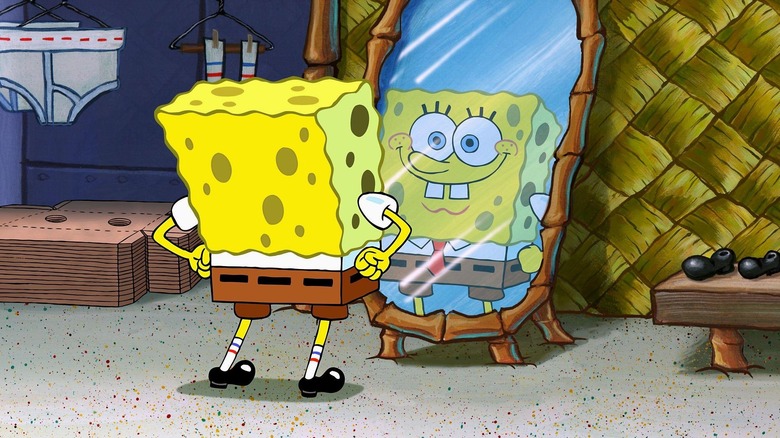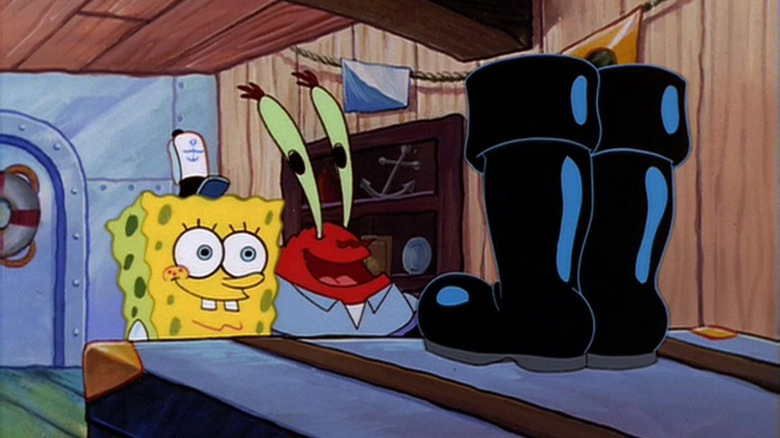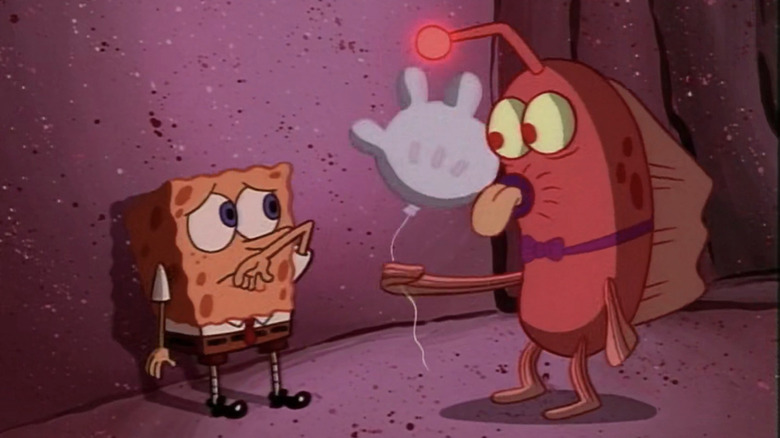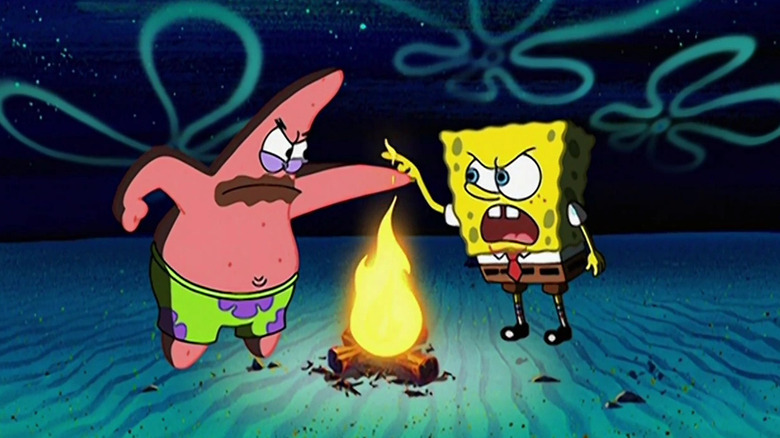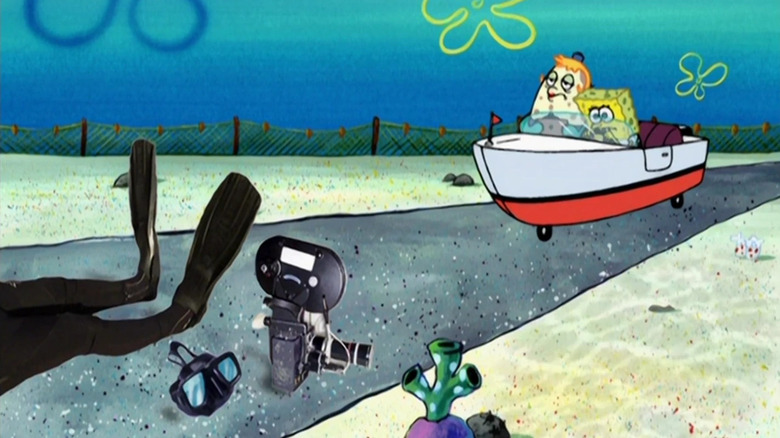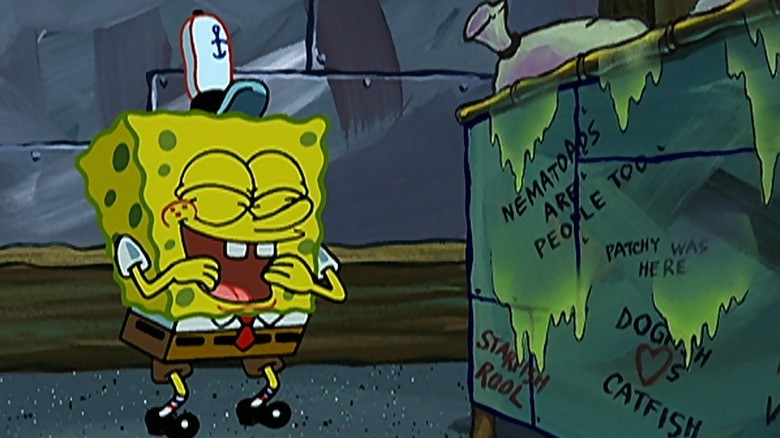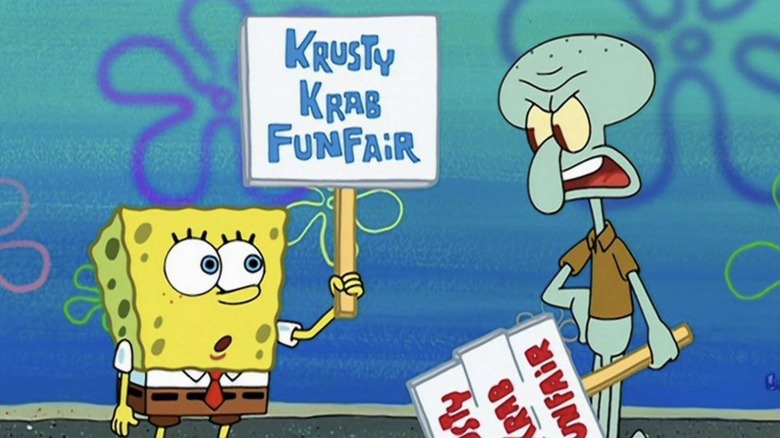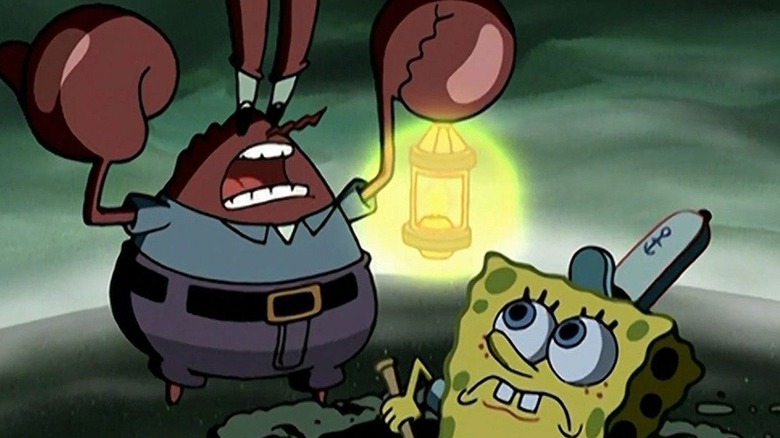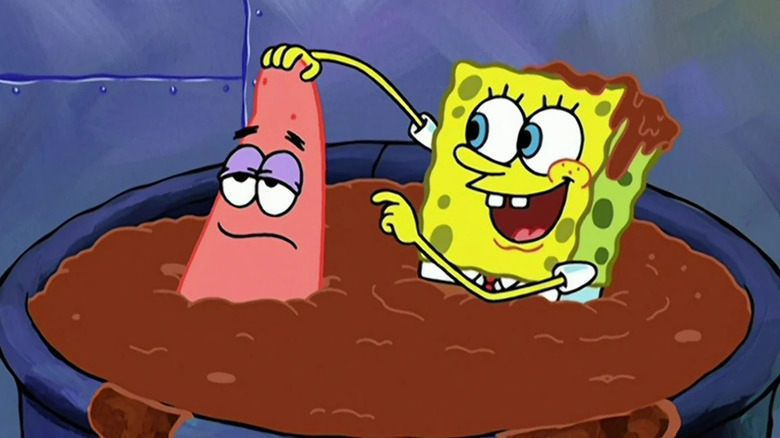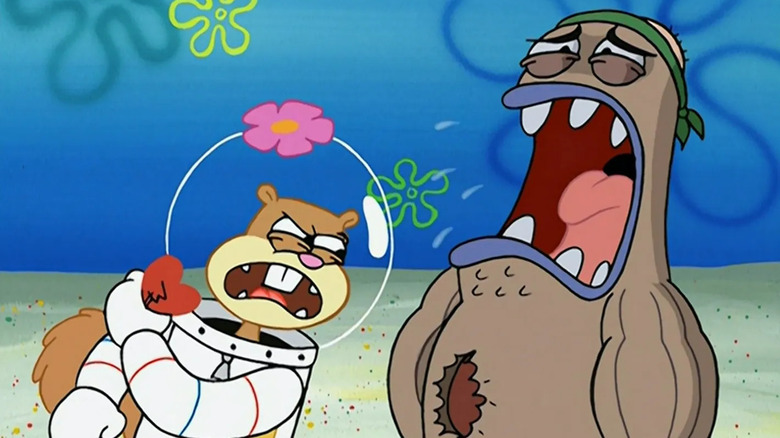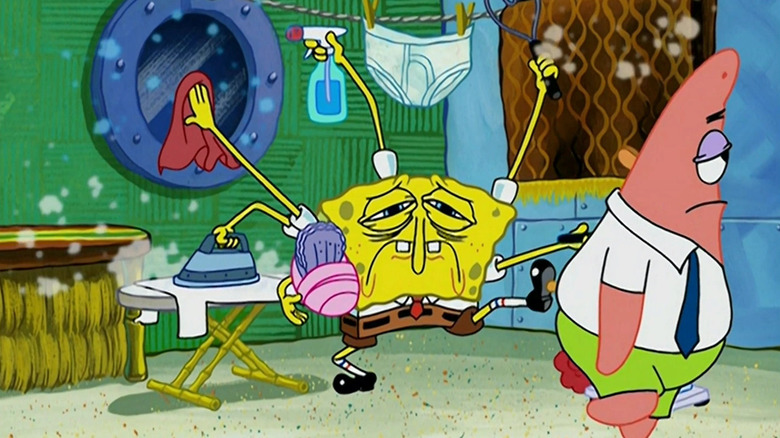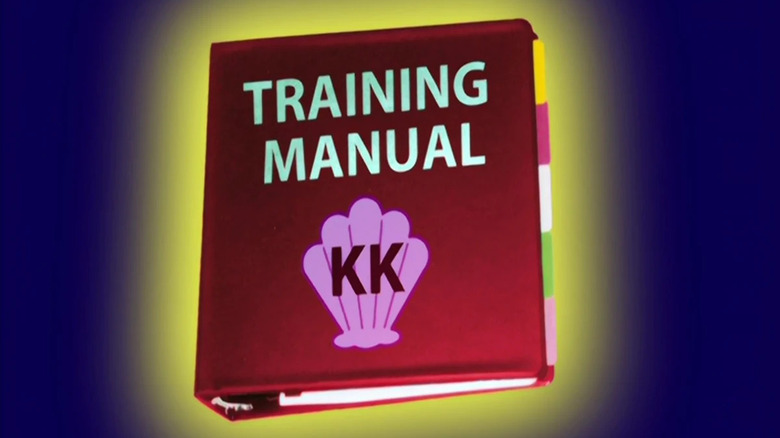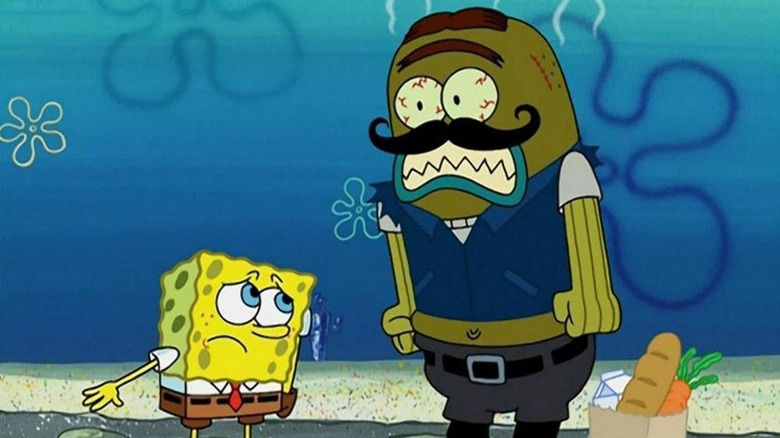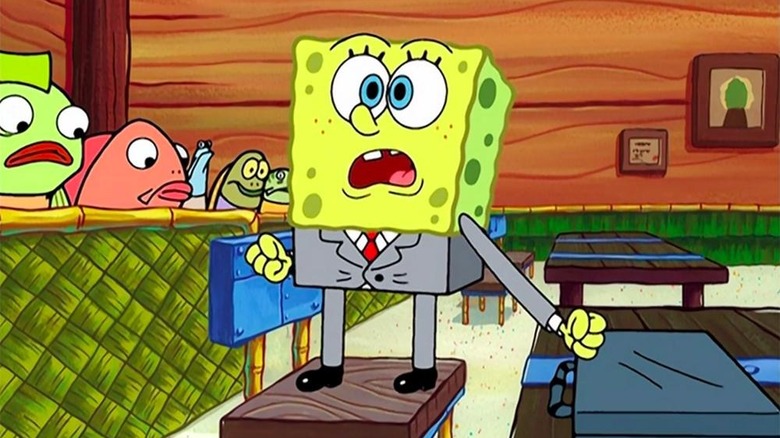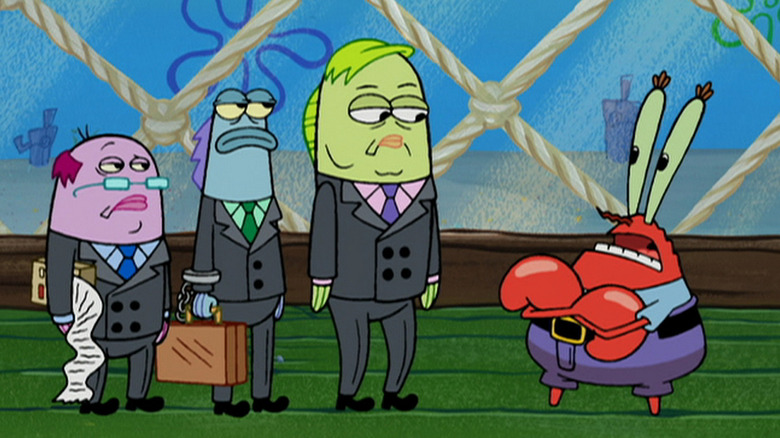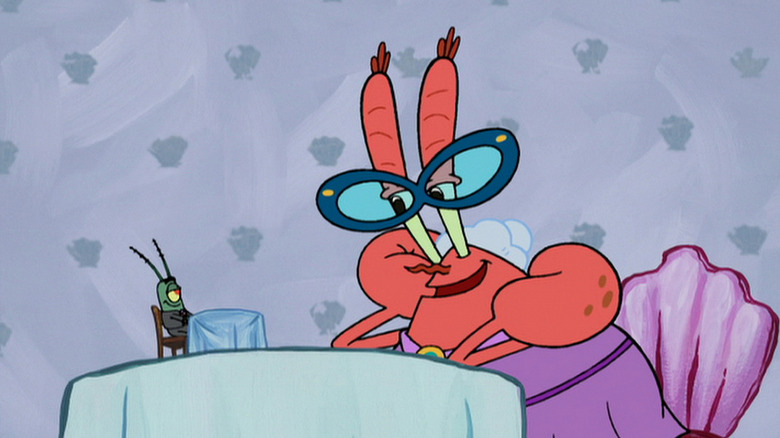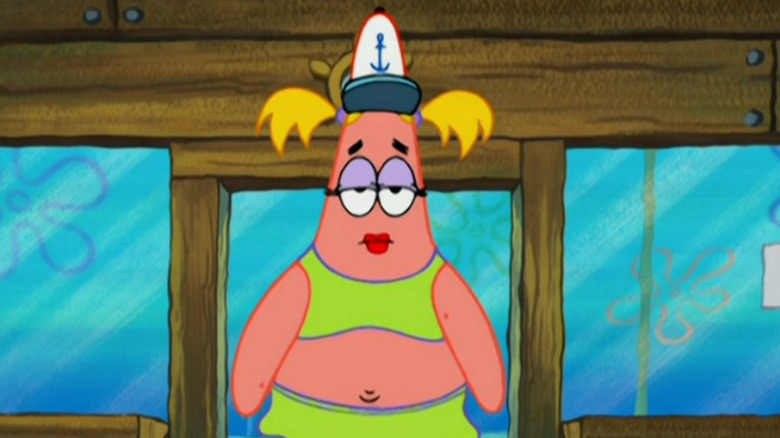SpongeBob SquarePants Episodes That Only Adults Understood
Nickelodeon has never been a network to shy away from adult humor, grown-up themes, and clever innuendos in their most popular children's programming. While some of their earliest shows, like "Ren & Stimpy" and "Rocko's Modern Life," were filled with double entendres that would be seen as controversial by today's standards, their content has over time become friendlier to kids (albeit still sometimes crossing over into territory that would be deemed not suitable for children).
"SpongeBob SquarePants" is the perfect example of a show that, albeit getting cleaner over time, had early seasons filled with jokes that could easily fly over the heads of younger viewers. However, "SpongeBob SquarePants" is also unique in that many of its premises touch on unusually complex subject matter. Episodes of "SpongeBob SquarePants" have centered on everything from animal cruelty to capitalism, as well as topics in morality and ethics that are quite sophisticated for the show's audience.
Now that many of those who watched "SpongeBob SquarePants" as kids are all grown up, they may want to revisit the following early episodes of the show with fresh eyes. Oftentimes, the jokes hit different in the cold light of adulthood. Whether SpongeBob and his friends get involved with surprisingly dark stories or satirize real-world problems in typical absurd Nickelodeon fashion, these episodes are memorable as some of the boldest to ever air on the network.
Squeaky Boots
The first season of "SpongeBob SquarePants" often took inspiration from more adult-centric literature. However, the episode "Squeaky Boots" was unique in that its premise originated in the original pitch bible created by Stephen Hillenburg in 1997. This pitch bible established that the episode was based on the famous Edgar Allan Poe short story "The Tell-Tale Heart," which follows a caretaker who is haunted by the heartbeat of the man he murdered and buried under the floorboards of his room until he's forced to confess.
The Poe influence remains in the episode, where Mr. Krabs pawns a pair of boots unwanted by his daughter Pearl to an oblivious SpongeBob. SpongeBob becomes inseparable from the boots, wearing them all the time and driving Mr. Krabs crazy with their squeaking sounds. Krabs eventually begins to hear the squeaks emanating from everything in his home, resulting in him breaking into SpongeBob's home to steal the boots and get rid of them. The next day, Krabs succumbs to his guilt and admits that he buried the squeaky boots underneath the floorboards of the Krusty Krab.
Given that younger audiences are likely unfamiliar with Edgar Allan Poe's work, the "Squeaky Boots" episode of "SpongeBob SquarePants" is clearly appealing to older viewers who perhaps get the reference. However, by changing a murdered man's heartbeat to silly, nonviolent old boots, kids may relate more to Mr. Krabs here.
Rock Bottom
"Rock Bottom" is one of the more memorable episodes in the first season of "SpongeBob SquarePants." After catching the wrong bus on their way back from Glove World, SpongeBob and Patrick end up stranded in the mysterious town of Rock Bottom. When SpongeBob again misses the bus, he ends up struggling to find a way back home, terrified by the strange sea creatures that occupy the unfamiliar area. As described by Variety in a list of the best "SpongeBob SquarePants" episodes, "The episode flips the usual dynamic of SpongeBob irritating his friends into losing their sanity by forcing him to experience what life is like in a world full of characters wackier than he is."
However, the wordplay behind the name "Rock Bottom" probably went unnoticed by many young viewers of Nickelodeon. As a phrase, "rock bottom" refers to an individual's emotional low point or depressive period. It's often deployed in the context of addiction. Similarly, SpongeBob finds himself at a low point here — not just geographically, given Rock Bottom's relation to Bikini Bottom, but because he spends most of the episode lost, scared, and frustrated at his predicament.
Nevertheless, Rock Bottom has remained a recurring locale throughout the franchise, sans the episode's thematic implications. In the video game, "SpongeBob SquarePants: Battle for Bikini Bottom," an entire level takes place in Rock Bottom, while the town also inspired a theme park ride at Minnesota's Mall of America.
Life of Crime
For a children's show, the characters in "SpongeBob SquarePants" often face serious consequences for their actions, including imprisonment or near-death. The Season 2 episode "Life of Crime" looks at what would happen if SpongeBob and Patrick actually had to confront those consequences, though their fear of having committed a crime is simply a mistake. In the episode, they nefariously steal a balloon and accidentally pop it, then go on the run as fugitives to escape punishment.
Unbeknownst to SpongeBob and Patrick, it's National Free Balloon Day in Bikini Bottom, but they nevertheless abandon their hometown. Storywise, it's the closest an episode of "SpongeBob SquarePants" comes to being a true crime episode, especially when SpongeBob and Patrick turn on each other and race to rat each other out for stealing a balloon. Even though the audience knows of their misunderstanding, it feels like a real threat to the characters' lives when two police officers put them in jail for several seconds before revealing the truth.
Although the ending leaves the characters with the moral that stealing is bad, the two friends still purposefully commit what they think is a crime. It's even revealed that Mr. Krabs is a kleptomaniac; his defense of stealing as "borrowing" is what prompts SpongeBob and Patrick's actions. Still, the threat of life in prison hanging over SpongeBob and Patrick in this episode is terrifying for younger viewers, even though adults will see it for what it is.
No Free Rides
It's quite common in animated shows, especially children's animation, for characters to make irresponsible decisions. However, none are quite as devastating as the "SpongeBob SquarePants" Season 2 episode "No Free Rides," where an exhausted Mrs. Puff finally gives SpongeBob his boating license in order to get him out of her life. This comes after a fourth-wall-breaking moment in the episode where SpongeBob accidentally runs over the show's narrator during his driving test, proving the real-life danger that SpongeBob driving a boat causes.
However, Mrs. Puff quickly begins to realize the disastrous consequences of her decision, dreaming about the possibility of SpongeBob recklessly running over the citizens of Bikini Bottom. It's a moment that's written well enough for kids to find humor in it, but the actual stakes of this likely resonate the most with adults who know what danger Mrs. Puff has just placed Bikini Bottom in. She resolves to steal the new boat that SpongeBob's parents have bought him, causing a chase where SpongeBob tries to take it back from the masked intruder.
The resulting incident places both Mrs. Puff and SpongeBob in jail, where Mrs. Puff decides to revoke SpongeBob's license and return to teaching him. Overall, the events of this episode are much more grounded in real-life stakes than most other episodes of "SpongeBob SquarePants." Fortunately, the narrator who gets hit at the episode's beginning returns in later episodes, proving that the stakes aren't as final as they initially appeared.
Sailor Mouth
One of the more infamously adult episodes of "SpongeBob SquarePants" starts when the titular fry cook takes out the trash and discovers a swear word written on the dumpster. After consulting Patrick, SpongeBob mistakenly accepts that it's a "sentence enhancer" and begins overusing it in the Krusty Krab, resulting in Mr. Krabs forbidding him from using it. Later, when SpongeBob accidentally blurts it out in front of Patrick, the two race to tattle on each other to Mr. Krabs.
While the swear words in the episode are instead replaced with nautical sound effects, the most prominent of those being a dolphin cry, behind the scenes it was a different story. During a panel in 2021, the voice actor for SpongeBob, Tom Kenny, admitted that while recording the dialogue for the episode, the actors found it easier to use real swear words rather than ad-lib fake ones, since Nickelodeon planned to edit them out anyway. However, it's unlikely that Nickelodeon will ever allow it to see the light of day.
Even with the swear words being censored, this episode of "SpongeBob SquarePants" garnered controversy for its subject matter. The Parent Television Council deemed the episode inappropriate, resulting in backlash from media publications defending the episode's condemnation of using bad words. However, it's best understood by adults who recall experiences of learning swear words, which was the case for the show's writers, with Stephen Hillenburg describing it as "a classic thing all kids go through" (via The Washington Post).
Squid on Strike
Concepts like unionization, worker exploitation, and going on strike are obviously not the concern of most children who spend their days watching Nickelodeon cartoons. They're incredibly prevalent issues for adults, though. However, "SpongeBob SquarePants" based a whole episode premise around striking during its second season with "Squid on Strike," which finds SpongeBob and Squidward going on strike to protest working conditions at the Krusty Krab.
Many aspects of strikes are parodied in "Squid on Strike," from SpongeBob desperately wanting his job at the Krusty Krab back to his terrible picket signs that convey the opposite message that they want from going on strike. After Squidward gives an impassioned speech about "dismantling the establishment," SpongeBob takes it the wrong way and ends up sneaking into the Krusty Krab and destroying it late at night, forcing the two to return to work to pay off the damages.
In one of the more grim endings to an episode of "SpongeBob SquarePants," the strike goes as poorly for the two workers as it possibly could've, mostly due to SpongeBob's errors. Though the episode introduces the concept of striking to children, it's probably not as effective in its satirization of the subject as it is for adults. However, publications like The Boar commended the episode for letting kids "have a subconscious understanding that they have rights and can fight for them."
Nasty Patty
Some episodes of "SpongeBob SquarePants" take the characters on a rollercoaster ride through situations no cartoon character could prepare for. That's certainly the case with "Nasty Patty," in which the Krusty Krab receives a surprise visit from a health inspector. However, after mistakenly believing him to be a fake, SpongeBob and Mr. Krabs feed him a moldy Krabby Patty that he chokes on and seemingly dies from, giving the two a dead body on their hands as they discover he was the real health inspector all along.
Rather than confess, Mr. Krabs and SpongeBob make an even darker decision than SpongeBob and Patrick did in "Life of Crime." The two drive to the middle of nowhere to bury the dead body, though they end up caught by unsuspecting police officers. They end up hitching a ride back to the Krusty Krab after stuffing the dead body in the police car's trunk, until later discovering that the health inspector was alive the entire time, absolving them of any real crime.
Nevertheless, "Nasty Patty" turns this episode of "SpongeBob SquarePants" from animated sitcom to true crime narrative. Even the episode's aesthetic is more reminiscent of a gritty drama than a children's cartoon. Though kids may enjoy the antics of SpongeBob and Mr. Krabs not realizing the health inspector is alive, their continued attempts at burying the evidence of their misdeed make it one of the more adult episodes of the Nickelodeon show.
Doing Time
"Doing Time" is another episode in the third season of "SpongeBob SquarePants" that centers on crime and punishment. This time around, the culprit is Mrs. Puff, who is arrested at the start of an episode as SpongeBob's driving test floods a nursing home with fruit punch, sadly destroying one resident's memoir written in red ink. In a surprising turn of events, Mrs. Puff's initial fear of being in prison goes away when she realizes that she gets to stay away from SpongeBob now.
Unfortunately for Mrs. Puff, SpongeBob and Patrick plan to break her out of prison anyway. Mrs. Puff tries to warn the guards of the potential break-in, but they eventually throw her into solitary confinement to shut her up. Even though Mrs. Puff believes herself to be safe now, she becomes haunted by the thought of the confinement room she's in being covered wall to wall in SpongeBob's face. However, in of the biggest twists in a "SpongeBob SquarePants" episode, Mrs. Puff wakes up back in a boat with SpongeBob moments before they crashed into the fruit punch truck in the beginning.
Even though the rest of the episode plays out with more "Inception"-esque dream sequences, the episode's content is quite an adult adventure for SpongeBob and his friends. It has that silly Nickelodeon absurdity young fans love, especially in one scene where SpongeBob and Patrick poorly attempt to rob a bank to get arrested.
No Weenies Allowed
While every episode of "SpongeBob SquarePants" examines mundane situations, the ones found in "No Weenies Allowed" are a lot more relatable for adult audiences rather than younger ones. The episode finds SpongeBob and Sandy seeking entry into the Salty Spittoon, a tavern where patrons have to prove how tough they are before getting in. Sandy earns her way in easily, ripping the bouncer's tattoo off his chest, while SpongeBob spends the episode struggling to prove how tough he is.
The episode's concept rests on the everyday premise of trying to get into a bar, which is most relatable to young adults having to prove they're old enough to enter somewhere that serves alcohol. Even SpongeBob's methods of trying to enter the Salty Spittoon play on tropes from movies and TV shows that adults would recognize better than younger audiences. In one moment, another sponge approaches the bouncer wearing a slicked black wig and acting like a drifter from out of town, which the bouncer assumes is a disguise, until the real SpongeBob approaches in a rainbow wig, confirming the drifter is legitimate.
Another sequence in the episode also makes a pop culture reference that's definitely too deep a cut for young fans of the show. SpongeBob recruits Patrick to lose in a fight to him in front of the bouncer, resulting in Patrick beating himself up, much like Edward Norton's character in David Fincher's "Fight Club" (Patrick's self-mutilation is a lot more absurd than the iconic thriller, though).
Rock-a-Bye Bivalve
"Rock-a-Bye Bivalve" is another season 3 episode of "SpongeBob SquarePants" that plays with life experiences that only adults would truly understand. In the episode, SpongeBob and Patrick discover a baby scallop and decide to raise it as their own child, with Patrick taking the role of the father and SpongeBob the mother. Unfortunately, this thrusts the two best friends into stereotypical gender roles, with SpongeBob taking care of the baby and home while Patrick spends the entire day at work, returns home exhausted, and watches TV without helping.
Eventually, SpongeBob confronts Patrick about his lack of parenting, revealing the multitude of diapers SpongeBob has hidden throughout the house, only to discover that Patrick's work day consists of him watching TV and eating ice cream. It's a rare moment to see the characters in "SpongeBob SquarePants" deal with issues of everyday domestic life that most married men and women are forced to confront. However, the episode's content also sparked controversy for its choice of character to face this struggle.
Over the years, "SpongeBob SquarePants" has faced criticism from some religious groups for implying that SpongeBob and Patrick are gay characters. However, this was disputed by The Harvard Crimson, which alleged that "if the episode truly depicted gay marriage, it would represent a gay marriage that implicitly follows heteronormative expectations by having both male individuals conform to a gender binary." Regardless, the gender identity concepts portrayed in this episode are more complex than many kids watching Nickelodeon could understand.
Krusty Krab Training Video
The "SpongeBob SquarePants" Season 3 episode "Krusty Krab Training Video" is one of the more uniquely structured episodes of the entire series. Rather than following an adventure or day in the life of Krusty Krab workers, the episode is instead framed as an instructional video for new Krusty Krab employees, similar to real-life retail jobs. This gives "SpongeBob SquarePants" an opportunity to lampoon corporations and capitalism through its off-brand humor.
While many gags appeal to childlike senses of humor (such as the restaurant's motto, "P.O.O.P," or People Order Our Patties), the episode also explores the dark backstory of the Krusty Krab. In a retrospective of Mr. Krabs' founding of SpongeBob's workplace, it's explained that he spent years after an unexplained war battling his way out of depression, eventually turning a bankrupt retirement home into a fast food restaurant. It's not explained what happened to said retirement home residents.
Other moments in the episode make dark, subtle jokes that only adult audiences would truly understand. One chapter of the training video focusing on "Interfacing With Your Boss" opens on a sinister slide depicting an electric chair, while Squidward's frustration with Patrick's inability to order perfectly captures the misery of being a fast food cashier dealing with customers. In a review for DVD Verdict, the episode was said to be "most appreciated by adults who've sat through any corporate rah-rah or training video at some point in their lives."
SpongeBob Meets the Strangler
Many episodes of "SpongeBob SquarePants" have placed SpongeBob's life in peril, even though the optimistic sea sponge was too oblivious to know it. A good example of that comes in the Season 3 episode "SpongeBob Meets the Strangler," where SpongeBob's work day is interrupted by the appearance of a notorious criminal known as the "Tattletale Strangler," whom SpongeBob inadvertently gets arrested for littering on Krusty Krab premises. When the Strangler escapes from captivity moments later, SpongeBob begins to fear for his life with a maniac on the loose.
In order to protect himself, SpongeBob hires a bodyguard, who just so happens to be the Strangler wearing a fake mustache. As SpongeBob continues to run errands in safety, the episode surprisingly follows the point-of-view of the Strangler, who tries to seize any opportunity to strangle SpongeBob, but keeps getting deterred. In one quite gruesome moment, SpongeBob tries to use the Strangler as a ladder and ends up horrifyingly piercing his eyes with his football cleats.
Although SpongeBob ends up driving the Strangler crazy enough to turn himself in by the end of the episode, the threat to his life was very much real throughout. There's even a subtle reference to the Strangler's serial killer personality with his prison number, "122068," which also happens to be the date of the first known murder of the Zodiac Killer.
Krabs vs. Plankton
"SpongeBob SquarePants" has not shied away from centering episodes on situations many people may find themselves in throughout their adult lives. In Season 4's "Krabs vs. Plankton," the characters of Bikini Bottom find themselves in a courtroom after Plankton fakes an injury on the Krusty Krab's property, opening Mr. Krabs up to be the target of a personal injury lawsuit. However, Mr. Krabs' freedom is in peril when SpongeBob takes over as his lawyer, resulting in a "SpongeBob Squarepants"-themed episode of "Law & Order."
Obviously, the episode pivots around a court trial, where Plankton easily wins over the jury by playing the sympathy card. Meanwhile, SpongeBob struggles to open the briefcase that contains Mr. Krabs' only necessary defense. SpongeBob finally wins over the jury when he breaks open the briefcase to reveal a single Krabby Patty, which he uses while cross-examining Plankton to bait Mr. Krabs' nemesis into trying to steal it, which he fails to do.
Many moments in the episode take inspiration from more adult shows that focus on criminal justice, which are references not many younger audiences will understand. For instance, many of the music stings throughout the episode are heavily reminiscent of songs from "Perry Mason" or the reality show "The People's Court," the latter of which features many cases similar to the personal injury one in this episode. Ultimately, while courtrooms may be unfamiliar territory for young "SpongeBob SquarePants" fans, adult viewers will know the experience of suing or being sued well.
Selling Out
Season 4 of "SpongeBob SquarePants" still manages to find new areas of satirizing the capitalist mindset of Mr. Krabs and how he operates the Krusty Krab. This comes to a boiling point in "Selling Out," where Krabs quickly accepts an offer to retire and sell the Krusty Krab to a group of suits. In a whirlwind of events, SpongeBob and Squidward find themselves working for a new manager, Carl, and his corporate chain "Krabby O'Monday's," an obvious reference to chain restaurants like T.G.I. Friday's.
In terms of "SpongeBob SquarePants" episodes that feature humorous takedowns of corporate conglomerates, "Selling Out" is one of the more brutal ones. When Squidward fails to represent the proper Krabby O'Monday's demeanor, he is threatened with being sent to Human Resources, which consists of a tough guy willing to beat him up. Later, Mr. Krabs gets bored of his early retirement and ends up getting a job as a busboy at Krabby O'Monday's, where he discovers that Krabby Patties are now being made with gray slime.
Although younger audiences may be unaware, this plot point references a major controversy with the fast food chain McDonald's, which was accused of making burgers out of "pink slime." Even though the company has denied these allegations, it's clearly referenced as a turning point where the customers at Krabby O'Monday's are horrified by what they've been eating. The restaurant is eventually rightfully returned to the ownership of Mr. Krabs, to everyone's delight.
Enemy In-Law
Plankton is a devious villain in "SpongeBob SquarePants," but one Season 4 episode takes his villainy to another level. The episode, titled "Enemy In-Law," finds Plankton falling in love with Betsy Krabs, the mother of his rival Mr. Krabs, to the Krusty Krab owner's horror. While Krabs tries to prove that his mother is marrying his enemy, he nevertheless faces resistance from others who believe that Plankton has found true love.
Although it may fly over the heads of children, the concept of Plankton dating and subsequently proposing to Mr. Krabs' mother, all in the effort of stealing the Krabby Patty secret formula, is pretty much as sadistic as it gets. Eventually, when Betsy succumbs to her son's fears and rejects Plankton, the Chum Bucket operator turns on her and threatens to destroy the Krusty Krab. However, Betsy unleashes her then-hidden muscles and kicks Plankton back into the Krusty Krab.
Even though the show never goes too far in how committed Plankton was to seducing Mr. Krabs' mother, the episode premise alone is a lot bolder than anything the show has done since.
That's No Lady
As seen in "Rock-a-Bye Bivalve," "SpongeBob SquarePants" has never been afraid to throw their central characters into opposing gender roles for the sake of comedy. Patrick gets his turn at cross-dressing with the Season 4 episode "That's No Lady." In one of the show's more ludicrous premises, when Patrick mistakenly fears getting assassinated, SpongeBob convinces him to change his identity to Patricia in order to avoid having to run away from Bikini Bottom.
Although it wasn't Patrick's intention, his portrayal of Patricia attracts the attention of every male fish in Bikini Bottom, particularly Mr. Krabs and Squidward, who fight for his/her affection. Once Patrick realizes he's not in danger of assassination (the assassin was actually selling a luxury resort vacation), he tears off his feminine clothes, exposing himself to the patrons of the Krusty Krab. In one of the series' most adult jokes, Squidward's eyes grow weary while Mr. Krabs shuts himself in his office.
With the obvious subject matter of "That's No Lady," it's clear why some kids may not fully understand the adult implications of Patrick dressing as a woman and getting unwanted attention from men. This is likely a relatable experience for many adult women, both trans and cis-gendered, who feel that people are nice to them for the wrong reasons. Hopefully not every citizen of Bikini Bottom was as devastated as Squidward and Krabs after learning the truth.
